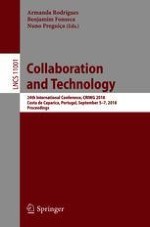2018 | Buch
Collaboration and Technology
24th International Conference, CRIWG 2018, Costa de Caparica, Portugal, September 5-7, 2018, Proceedings
herausgegeben von: Prof. Armanda Rodrigues, Benjamim Fonseca, Prof. Nuno Preguiça
Verlag: Springer International Publishing
Buchreihe : Lecture Notes in Computer Science
